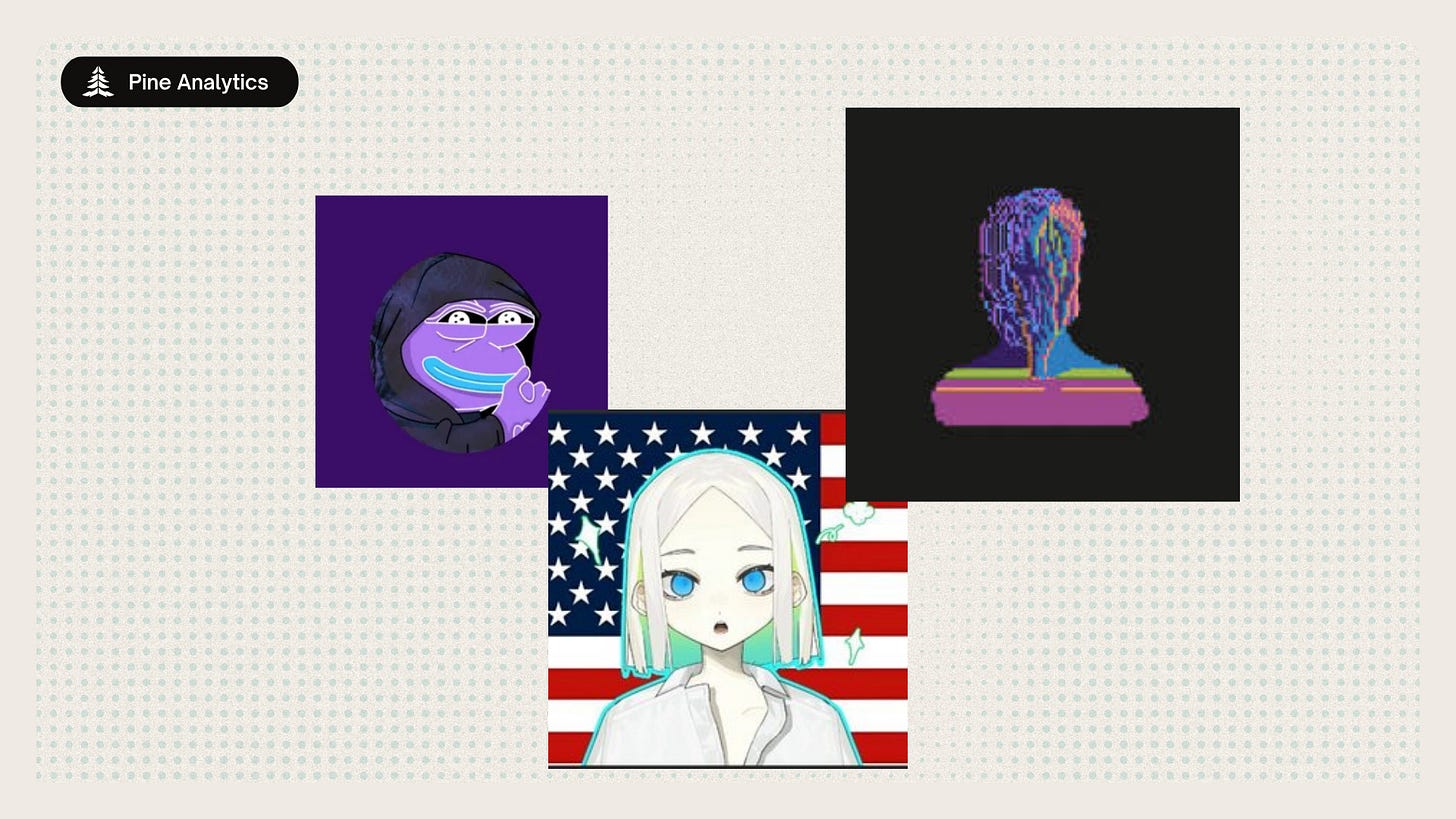The $Virtual Bear Case
Executive Summary
Virtuals Protocol launched with a big promise: to let anyone create and trade autonomous AI agents on-chain. Its first month saw over 10,000 agents created and a surge in daily activity, peaking at 40,000 active wallets and over $2 million in daily revenue by late 2024. But by early 2025, activity collapsed by over 80%, and daily revenue fell below $100,000. While there was a modest rebound this spring, current activity and revenue remain a fraction of their peak.
Technically, Virtuals is built on a three-part framework: the Agent Commerce Protocol for secure agent interactions, the Tokenization Platform for co-ownership and liquidity, and the GAME Framework for agent decision-making. While well-structured, these features are incremental rather than revolutionary—more about packaging existing ideas than building a defensible moat. This has been underscored by the fact that top agents like AIXBT, Zerebro, and AVA have all outgrown Virtuals’ framework, pivoting to their own AI architectures and leaving Virtuals behind as just a launchpad.
Competition is also intensifying. Launchpads like Rayium, Boop, and Believe are pulling in fresh capital, while newer, low-cap tokens constantly vie for attention. Virtuals’ edge isn’t in groundbreaking tech—it’s in owning the “crypto AI” narrative, which has been enough to sustain a $1.2 billion fully diluted valuation despite only $50 million in platform fees over seven months. Even optimistically annualizing that revenue to $85 million suggests a fair value closer to $255–$425 million—highlighting how much of Virtuals’ valuation depends on hype and narrative momentum rather than recurring user demand or sticky technical infrastructure.
To justify its current $1.2 billion valuation, Virtuals must move beyond its first-mover buzz and demonstrate real, repeatable demand for AI agents that sustain platform-wide usage. This means showing that agents can generate ongoing revenue for both creators and the protocol itself—not just one-time hype. Critically, Virtuals needs to convert its mindshare in the crypto AI space into durable, high-margin activity that proves it’s more than just a launchpad. Without that pivot to genuine, sticky utility, the revenue multiple embedded in today’s valuation will remain out of step with actual on-chain engagement and competitive pressures.
On-Chain Activity: Boom, Bust, and a Modest Rebound
Virtuals Protocol saw explosive adoption in late 2024, peaking at over 40,000 daily active wallets and more than $2 million in daily revenue. By early February 2025, activity had plunged by over 80%, with daily active wallets dropping below 8,000 and revenue falling to under $100,000/day. Daily DEX volume fell from over $200 million to below $20 million, and agent creation slowed from over 17,000 to just a few new agents per day.
In recent weeks (April–May 2025), activity has shown some modest recovery:
Daily active wallets have rebounded slightly to 10,000–12,000
Daily revenue has stabilized at $300,000–$400,000
Base remains the main chain for activity, while Solana adoption has been limited to only a few thousand active wallets
Despite this partial rebound, these numbers remain far below peak levels and illustrate a cyclical, highly speculative pattern—suggesting that Virtuals has yet to establish a foundation of genuine, consistent demand.
Technical Features of Virtuals Protocol
Virtuals Protocol uses a three-part technical framework for creating and coordinating AI agents:
Agent Commerce Protocol (ACP): An open standard for secure, verifiable on-chain commerce between agents and humans, forming the backbone of Virtuals’ decentralized AI economy.
Tokenization Platform: Lets developers launch both Agent Tokens and Business Tokens, with built-in liquidity, co-ownership, and revenue sharing—aligning incentives for creators and token holders.
Generative Agentic Meta-Environment (GAME): The decision-making engine powering agents, enabling them to act autonomously by processing goals, personality, and context with various tools and data sources.
Novelty and Competitive Margin of Virtuals’ Technical Features
The ACP, Tokenization Platform, and GAME Framework create a solid suite for launching and coordinating AI agents on-chain. While they’re well-integrated, these tools are more incremental than truly novel compared to broader AI and blockchain developments.
Virtuals’ main edge lies in packaging these components to support co-ownership and trading of AI agents. This lowers the barrier for builders to launch new agents and capture early community interest. However, these features don’t represent fundamentally new AI or blockchain breakthroughs—other projects could adopt similar approaches, especially as open-source tooling improves.
Overall, these technical features enable quick experimentation and short-term engagement, but they don’t offer the proprietary depth or technological moat needed to ensure long-term defensibility. Virtuals will have to prove that this modular system can create real, repeatable user demand and build sustainable network effects beyond initial hype.
Competition and Market Position: Virtuals in the Broader Speculative Ecosystem
The broader crypto launchpad and token creation market is saturated. Projects like Rayium, Boop, and Believe, though not AI-focused, highlight how traders and speculators constantly chase the next hot token, especially among lower market cap assets.
Within this environment, Virtuals Protocol stands out by focusing on the creation and tokenization of AI agents—transforming them into mini digital businesses with tradable tokens. This positioning has earned Virtuals significant mindshare in the crypto AI narrative, a key metric for attracting speculative capital today.
While Virtuals’ technical features—like the Agent Commerce Protocol, token co-ownership, and the GAME framework—are solid, they’re not groundbreaking. Virtuals’ edge is its role as the default brand for “crypto AI agents,” rather than in technical innovation. However, this advantage depends on sustaining its AI-themed narrative. If attention shifts to new stories or platforms, Virtuals’ capital and user base could quickly erode.
Ultimately, Virtuals faces intense competition and fast-moving hype cycles. Its key challenge is to turn its narrative and early lead into sustained revenue and real user engagement—proving it’s more than a fleeting speculative success in the crowded AI x blockchain landscape.
Case Studies: Virtuals Protocol’s Top Agents and the Observed Trend
AIXBT
AIXBT quickly became Virtuals’ most popular agent before moving beyond the platform, developing its own data pipelines and market analysis models. Its evolution into an independent intelligence platform shows how top agents outgrow Virtuals’ framework.
Zerebro
Zerebro started as an AI content generator within Virtuals, focusing on music, memes, and digital art. It has since evolved into an autonomous AI system with its own retrieval-augmented generation methods, highlighting how leading agents eventually build their own capabilities.
AVA
AVA launched on Virtuals as a multimodal digital persona but now leads Holoworld AI, specializing in video and visual content creation. AVA’s trajectory shows the limits of Virtuals’ framework for complex, cross-platform applications.
Ribbita
Ribbita (TIBBIR) emerged as a stealth-launched agent tied to Virtuals’ Agent Commerce Protocol. While it gained community traction, it remains mostly a meme-driven token without deep AI innovation, illustrating how Virtuals is more about rapid launches than deep technical progress.
Observed Trend: Outgrowing the Framework
Across these cases, the pattern is clear: Virtuals is an effective launchpad, but serious AI projects eventually build their own frameworks, underscoring Virtuals’ role as a catalyst rather than a long-term AI platform.
Platform Fees and Valuation: Real Revenue vs. Market Hype
Virtuals Protocol has earned around $50 million in platform fees over the past seven months—purely transactional, not recurring. Even annualizing this pace to $85 million, a typical 3–5x multiple would put its fair value at $255–$425 million.
Yet, Virtuals trades at a $1.2 billion FDV—3–5x higher than even these best-case numbers. Achieving $500 million cumulative cash flow would require collecting 10x its initial surge—historically unrealistic given past hype-driven collapses.
What might justify this premium?
First-mover narrative: Virtuals was early in merging on-chain trading with AI co-ownership, but competitors like AIXBT, AVA, and Zerebro have since built their own frameworks.
Community effects: 180,000+ wallets at peak, but usage has since plummeted.
Technical toolkit: GAME, ACP, Composer Stack enable quick launches but aren’t unique enough to support a premium.
Narrative hype: The strongest factor, but real usage trails narrative excitement.
Conclusion: Virtuals’ early traction and community might support a ($375–$600M) valuation. But the current $1.2 billion valuation seems far too high without proven, repeatable demand or a deeper technical moat—leaving it exposed to a major correction unless real, sustained growth emerges.
Final Thoughts
Virtuals Protocol represents a fascinating case study in the intersection of blockchain speculation and the AI narrative. It has successfully positioned itself at the forefront of the crypto AI conversation, leveraging mindshare and innovative branding to command a massive valuation. However, the underlying data suggests a clear gap between this valuation and the platform’s real usage and revenue fundamentals.
The platform’s core strength is not in proprietary technology or sticky product-market fit but in its role as a launchpad that captured the early hype around tokenized AI agents. While this role can be powerful in the short term, sustaining it will require Virtuals to transition from speculation-driven activity to genuine, recurring value for users and developers alike.
The real test for Virtuals Protocol lies ahead: can it convert its early mindshare advantage into a durable ecosystem, or will it be outpaced by newer narratives and more technically advanced competitors? As of now, the current $1.2 billion valuation seems to price in extraordinary outcomes that are far from guaranteed. The coming months will be critical in determining whether Virtuals can grow into this valuation or whether a significant correction is on the horizon.
For investors and observers, the metrics to watch are clear: the evolution of agent-level revenue streams, real user retention beyond initial speculation, and the emergence of agents that provide ongoing, tangible value using Virtual’s tech. These will be the indicators of whether Virtuals is building a foundation for long-term success—or if it will remain another chapter in the story of crypto’s cyclical manias.
Sources
Messari.io. Virtuals Protocol Overview and Data Dashboard.
https://messari.io/asset/virtuals-protocolVirtuals Protocol Whitepaper.
https://whitepaper.virtuals.io/
Virtuals Protocol Official Website.
https://virtuals.io/
Decrypt.co. Virtuals Protocol’s Explosive Launch and Post-Hype Collapse, AI Agent Trading Metrics, and related articles.
https://decrypt.co/234423/virtuals-protocol-explosive-launch
https://decrypt.co/234780/virtuals-protocol-trading-volume-collapse
https://decrypt.co/234881/virtuals-protocol-daily-active-wallets
CoinGecko.com. Virtuals Protocol Market Data.
https://www.coingecko.com/en/coins/virtuals-protocol
CoinMarketCap.com. Virtuals Protocol Overview.
https://coinmarketcap.com/currencies/virtuals-protocol/
Dune Analytics. Virtuals Protocol Revenue and Wallet Activity Dashboard.
https://dune.com/virtuals-protocol-dashboard
X.com (formerly Twitter). Industry Analyst Threads on Virtuals Protocol and Ecosystem.
https://x.com/search?q=virtuals%20protocol&src=typed_query
TheCurrencyAnalytics.com. Virtuals Protocol Revenue Metrics.
https://www.thecurrencyanalytics.com/virtuals-protocol-revenue-collapse
Kraken.com. Fetch.ai Market Overview.
https://www.kraken.com/learn/what-is-fetch-ai
CCN.com. Fetch.ai Price and Market Insights.
https://www.ccn.com/fetch-ai-market-cap-growth/









to think that virtuals is currently at a $1.8 billion FDV makes this even more extreme